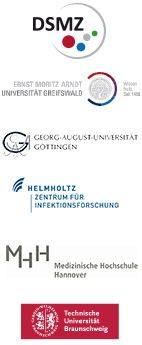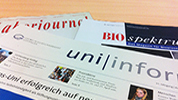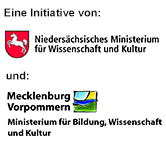NZMG - Norddeutsches Zentrum für Mikrobielle Genomforschung



Publikationen aus den NZMG-Partnerprojekten |
( 2022 - 2021 - 2020 - 2019 - 2018 - 2017 - 2016 - 2015 - 2014 - 2013 )
Publikationen 2022
Brauer M, Hotop SK, Wurster M, Herrmann J, Miethke M, Schlüter R, Dittmann S, Zühlke D, Brönstrup M, Lalk M, Müller R, Sievers S, Bernhardt J, Riedel K (2022) Clostridioides difficile modifies its aromatic compound metabolism in response to Amidochelocardin-induced membrane stress. mSphere 7(5):e0030222. (abstract)
Dlugosch L, Poehlein A, Wemheuer B, Pfeiffer B, Badewien TH, Daniel R, Simon M (2022) Significance of gene variants for the functional biogeography of the near-surface Atlantic Ocean microbiome. Nat Commun 11:1186. (abstract)
Dougan K, Deng Z-L, Wöhlbrand L, Reuse C, Bunk B, Chen Y, Hartlich J, Hiller K, John U, Kalvelage J, Mansky J, Neumann-Schaal M, Overmann J, Petersen J, Sanchez S, Schmidt-Hohagen K, Shah S, Spröer C, Sztajer H, Wang H, Bhattacharya D, Rabus R, Jahn D, Chan CX, Wagner-Döbler I (2022) Multi-omics analysis reveals the molecular response to heat stress in a “red tide” dinoflagellate. bioRxiv (abstract)
Metzendorf NG, Lange LM, Lainer N, Schlüter R, Dittmann S, Paul LS, Troitzsch D, Sievers S (2022) Destination and specific impact of different bile acids in the intestinal pathogen Clostridioides difficile. Front Microbiol 13:814692. (abstract)
Publikationen 2021
Brauer M, Lassek C, Hinze C, Hoyer J, Becher D, Jahn D, Sievers S, Riedel K (2021) What's a biofilm?-How the choice of the biofilm model impacts the protein inventory of Clostridioides difficile. Front Microbiol 12:682111. (abstract)
Hofmann JD, Biedendieck R, Michel AM, Schomburg D, Jahn D, Neumann-Schaal M (2021) Influence of L-lactate and low glucose concentrations on the metabolism and the toxin formation of Clostridioides difficile. PLOS ONE 16:e0244988. (abstract)
Schneider D, Zühlke D, Poehlein A, Riedel K, Daniel R (2021) Metagenome-assembled genome sequences from different wastewater treatment stages in Germany. Microbiol Resour Announc 10(27):e00504-21. (abstract)
Troitzsch D, Zhang H, Dittmann S, Düsterhöft D, Möller TA, Michel AM, Jänsch L, Riedel K, Borrero-de Acuña JM, Jahn D, Sievers S (2021) A point mutation in the transcriptional repressor PerR results in a constitutive oxidative stress response in Clostridioides difficile 630Δerm. mSphere 6(2):e00091-21. (abstract)
Publikationen 2020
Frentrup M, Zhou Z, Steglich M, Meier-Kolthoff JP, Göker M, Riedel T, Bunk B., Sproer C, Overmann J, Blaschitz M, Indra A, von Müller L, Kohl TA, Niemann S, Seyboldt C, Klawonn F, Kumar N, Lawley TD, Garcia-Fernandez S, Canton R, Del Campo R, Zimmermann O, Gross U, Achtman M, Nübel U (2020) A publicly accessible database for Clostridioides difficile genome sequences supports tracing of transmission chains and epidemics. Microb Genom 6(8):mgen000410. (abstract)
Hollensteiner J, Schneider D, Poehlein A, Daniel R (2020) Complete genome of Roseobacter ponti DSM 106830T. Genome Biol Evol evaa114. (abstract)
Nacke H, Kirck LL,Schwarz S, Schneider D, Poehlein A, Daniel R (2020) Metagenome sequences of a wastewater treatment plant digester sludge-derived enrichment culture. Microbiol Resour Announc 9(32):e00712-20. (abstract)
Troitzsch D, Zhang H, Dittmann S, Düsterhöft D, Michel A.M, Jänsch L, Riedel K, Borrero-de Acuna JM, Jahn D, Sievers S (2020) Work horse strain Clostridioides difficile 630Δerm is oblivious to its anaerobic lifestyle. bioRxiv (abstract)
Publikationen 2019
Bakenhus I, Wemheuer B, Akyol P, Giebel HA, Dlugosch L, Daniel R, Simon M (2019) Distinct relationships between fluorescence in situ hybridization- and rRNA gene- and amplicon-based sequencing data of bacterioplankton lineages. System Appl Microbiol 42(5):126000. (abstract)
Berger FK, Mellmann A, von Müller L, Bischoff M, Gärtner BC (2019) Quality assurance for genotyping and resistance testing of Clostridium (Clostridioides) difficile isolates - Experiences from the first inter-laboratory ring trial in four German speaking countries. Anaerobe 61:102093. (abstract)
Berger FK, Gfrörer S, Becker SL, Baldan R, Cirillo DM, Frentrup M, Steglich M, Engling P, Nübel U, Mellmann A, Bischoff M, Gärtner B, von Müller L (2019) Hospital outbreak due to Clostridium difficile ribotype 018 (RT018) in Southern Germany. Int J Med Microbiol 309(3-4):189-193.
Emele MF, Joppe FM, Riedel T, Overmann J, Rupnik M, Cooper P, Kusumawati RL, Laukien F, Zimmermann O, Bohne W, Groß U, Bader O, Zautner AE (2019) Proteotyping of Clostridioides difficile as alternate typing method to ribotyping is able to differentiate the ribotype 027 from other ribotypes. Frontiers Microbiol 20:2087.
Frentrup M, Zhou Z, Steglich M, Meier-Kolthoff JP, Göker M, Riedel T, Bunk B, Spröer C, Overmann J, Blaschitz M, Indra A, Von Müller L, Kohl TH, Niemann S, Seyboldt C, Klawonn F, Kumar N, Lawley TD, Garcia-Fernandez S, Canton R, Del Campo R, Zimmermann O, Groß U, Achtman M, Nübel U (2019) Global genomic population structure of Clostridioides difficile. bioRxiv (abstract)
Hollensteiner J, Poehlein A, Daniel R (2019) Complete genome sequence of Marinobacter sp. strain JH2, isolated from seawater of the Kiel Fjord. Microbiol Resour Announc 8(30):e00596-19. (abstract)
Mamareli P, Kruse F, Friedrich C, Smit N, Strowig T, Sparwasser T, and Lochner M (2019) Epithelium-specific MyD88 signaling, but not DCs or macrophages, control acute intestinal infection with Clostridium difficile. Eur J Immunol 49(5):747-757.
Neumann-Schaal M, Jahn D, Schmidt-Hohagen K (2019) Metabolism the difficile way: The key to the success of the pathogen Clostridioides difficile. Front Microbiol 10:219. (abstract)
Pich A, Junemann J, Stieglitz F, Schweitzer T (2019) Clostridioides difficile-Toxine verändern das Proteom von Darmzellen. Biospektrum
Tao L, Tian S, Zhang J, Liu Z, Robinson-McCarthy L, Miyashita SI, Breault DT, Gerhard R, Oottamasathien S, Whelan SPJ, Dong M (2019) Sulfated glycosaminoglycans and low-density lipoprotein receptor contribute to Clostridium difficile toxin A entry into cells. Nat Microbiol 4(10):1760-1769.
Publikationen 2018
Beer LA, Tatge H, Schneider C, Ruschig M, Hust M, Barton J, Thiemann S, Fühner V, Russo G and Gerhard R (2018) The binary toxin CDT of Clostridium difficile as a tool for intracellular delivery of bacterial glucosyltransferase domains. Toxins doi:10.3390/toxins.10060225.
Eckweiler D, Dudek CA, Hartlich J, Brötje D, Jahn D (2018) PRODORIC2: the bacterial gene regulation database in 2018. Nucleic Acids Res 46(D1):D320-D326.
Groß U, Brzuszkiewicz E, Gunka K, Starke J, Riedel T, Bunk B, Spröer C, Wetzel D, Poehlein A, Chibani C, Bohne W, Overmann J, Zimmermann O, Daniel R, Liesegang H (2018) Comparative genome and phenotypic analysis of three Clostridioides difficile strains isolated from a single patient provide insight into multiple infection of C. difficile. BMC Genomics 19:1. (abstract)
Hofman J, Otto A, Berges M, Biedendieck R, Michel A-M, Becher D, Jahn D, Neumann-Schaal M (2018) Metabolic reprogramming of Clostridioides difficile during the stationary phase with the induction of toxin productions. Front Microbiol 9:1970.
Moreiro GMSG, Fühner V, Hust M (2018) Epitope mapping by phage display. Methods Mol Biol 1701:497-518.
Neumann-Schaal M, Metzendorf NG, Troitzsch D, Nuss AM, Hofmann JD, Beckstette M, Dersch P, Otto A, Sievers (2018) Tracking gene expression and oxidation damage of O2-stressed Clostridioides difficle by a multiomics approach. Anaerobe doi:10.1016/j.anaerobe.2018.
Sachsenheimer FE, Yang I, Zimmermann O, Wrede C, Müller LV, Gunka K, Groß U, Suerbaum S (2018) Genomic and phenotypic diversity of Clostridium difficile during long-term sequential recurrences of infection. Int J Med Microbiol 17:30421-6.
Schöttelndreier D, Seeger K, Grassl GA, Winny MR, Lindner R, Genth H (2018) Expression and (lacking) internalization of the cell surface receptors of Clostridioides difficile toxin B. Front Microbiol doi:10.3389/fmicb.2018.01483.
Schwemmlein N, Pippel J, Gazdag E-M, Blankenfeldt W (2018) Crystal structures of R-type bacteriocin sheath and tube proteins CD1363 and CD1364 from Clostridioides difficile in the pre-assembled state. Front Microbiol doi:10.3389/fmicb.2018.01750.
Seugendo M, Janssen I, Lang V, Hasibuan I, Bohne W, Cooper P, Daniel R, Gunka K, Kusumawati RL, Mshana S, von Müller L, Okamo B, Ortlepp J, Overmann J, Riedel T, Rupnik M, Zimmermann O, Groß U (2018) Prevalence and strain characterization of Clostridioides (Clostridium) difficile in representative regions of Germany, Ghana, Tanzania and Indonesia - a comparative multi-center cross-sectional study. Front Microbiol doi:10.3389/fmicb.2018.01843.
Steglich M, Hofmann J, Helmecke J, Sikorski J, Spröer C, Riedel T, Bunk B, Neumann-Schaal M, Nübel U (2018) Convergent loss of ABC transporter genes from Clostridioides difficile genomes is associated with impaired tyrosine uptake and p-cresol production. Front Microbiol doi:10.3389/fmicb.2018.00901.
Weber T, Namikawa K, Winter B, Müller-Brown K, Kühn R, Wurst W & Köster RW (2018) Caspase-mediated apoptosis induction in zebrafish cerebellar Purkinje neurons. Development 143:4279-4287.
Publikationen 2017
Dannheim H, Riedel T, Neumann-Schaal M, Bunk B, Schober I, Spröer C, Chibani CM, Gronow S, Liesegang H, Overmann J, Schomburg D (2017) Manual curation and reannotation of the genomes of Clostridium difficile 630Δerm and Clostridium difficile 630. J Med Microbiol 66(3):286-293. (abstract)
Dannheim H, Will SE, Schomburg D, Neumann-Schaal M (2017) Clostridioides difficile 630Δerm in silico and in vivo - quantitative growth and extensive polysaccharide secretion. FEBS Open Bio 7:602-615.
Erdmann J, Junemann J, Schröder A, Just I, Gerhard R, Pich A (2017) Glucosyltransferase dependent and independent effects of TcdB on the proteome of HEp-2 cells. Proteomics 17:15-16.
Junemann J, Birgin G, Erdmann J, Schröder A, Just I, Gerhard R, Pich A (2017) Toxin A of the nosocomial pathogen Clostridium difficile induces early effects in the proteome of HEp-2 cells. Proteomics Clin Appl 11:3-4.
Junemann J, Lämmerhirt CM, Polten F, Just I, Gerhard R, Genth H, Pich A (2017) Quantification of small GTPase glucosylation by clostridial glucosylating toxins using multiplexed MRM analysis. Proteomics 2017 May;17(9).
Riedel T, Wittmann J, Bunk B, Schober I, Spröer C, Gronow S & Overmann JA (2017) Clostridioides difficile bacteriophage genome encodes functional binary toxin-associated genes genes. J Biotechnol 250:23-28.
Riedel T, Wetzel D, Hofmann JD, Plorin SPEO, Dannheim H, Berges M, Zimmermann O, Bunk B, Schober I, Spröer C, Liesegang H, Jahn D, Overmann J, Groß U,Neumann-Schaal M (2017) High metabolic versatility of different toxigenic and non-toxigenic Clostridioides difficile isolates. Int J Med Microbiol 307(6):311-320.
Ruhe F, Olling A, Abromeit R, Rataj D, Grieschat M, Zeug A, Gerhard R & Alekov A (2017) The endosomal anion/proton exchanger ClC-5 increases cell susceptibility towards Clostridium difficile toxins TcdA and TcdB. Frontiers Cell Infect Microbiol 7:67.
Sassen WA, Lehne F, Russo G, Wargenau S, D&uumk;bel S, Köster RW (2017) Embryonic zebrafish primary cell culture for transfection and live cellular and subcellular imaging. Developmental Biology 430:18-31.
Schneider D, Thürmer A, Gollnow K, Lugert R, Gunka K, Groß U, Daniel R (2017) Gut bacterial communities of diarrheic patients with indications of Clostridioides difficile infection. Sci Data 2017 Oct 17;4:170152.
Solbach P, Dersch P, Bachmann O (2017) Individualized treatment strategies for Clostridium difficile infections. Internist (Berl) 58(7):675-681.
Steglich M & Nübel U (2017) The challenge of detecting indels in bacterial genomes from short-read sequencing data. J Biotechnology 250:11-15.
Publikationen 2016
Nonnenmacher Y, Palorini R, d'Herouël AF, Krämer L, Neumann-Schaal M, Chiaradonna F, Skupin A, Wegner A, Hiller K (2016) Analysis of mitochondrial metabolism in situ: Combining stable isotope labeling with selective permeabilization. Metab Eng pii: S1096-7176(16)30246-4.
Billerbeck S, Wemheuer B, Voget S, Poehlein A, Giebel H-A, Brinkhoff T, Gram L, Jeffrey WH, Daniel R, Simon M (2016) Biogeography and environmental genomics of the Roseobacter-affiliated pelagic CHAB-I-5 lineage. Nature Microbiol 1:16063. (abstract)
Frädrich C, Beer LA & Gerhard R (2016) Reactive oxygen species as additional determinant for cytotoxicity of Clostridium difficile toxins A and B. Toxins 8(1):25.
Genth H, Schelle I, Just I (2016) Metal ion activation of Clostridium sordellii lethal toxin and Clostridium difficile toxin B. Toxins (Basel) 16 8(4):109.
Gerhard R (2016) Receptors and binding structures for Clostridium difficile Toxins A and B. Current Topics in Microbiology and Immunology 406:79-96.
Janssen I, Cooper P, Gunka K, Rupnik M, Wetzel D, Zimmermann O, Groß U (2016) High prevalence of nontoxigenic Clostridium difficile in rural Ghana: a cross-sectional, single-centre study. Int J Med Microbiol 306(8):652-665.
Kanukollu S, Wemheuer B, Herber J, Billerbeck S, Lucas J, Daniel R, Simon M, Cypionka H, Engelen B (2016) Distinct compositions of free-living, particle-associated and benthic communities of the Roseobacter group in the North Sea. FEMS Microbiol Ecol 92(1):fiv137. (abstract)
Kuhn, P, Fühner, V, Moreira, GMSG, Frenzel, A, Miethe, S and Hust, M (2016) Recombinant antibodies for diagnostics and therapy against pathogens and toxins generated by phage display. Proteomics - Clinical Applications 10:922-948.
Osterholz H, Singer G, Wemheuer B, Daniel R, Simon M, Niggemann J, Dittmar T (2016) Deciphering associations between dissolved organic molecules and bacterial communities in a pelagic marine system. ISME J 1-14. (abstract)
Otto A, Maass S, Lassek C, Becher D, Hecker M, Riedel K and Sievers S (2016) The protein inventory of Clostridium difficile grown in complex and minimal medium. Proteomics Clin Appl 10:1068-1072.
Rohrbeck, A, Fühner, V, Schröder, A, Hagemann, S, Vu, X-H, Berndt, S, Hust, M, Pich, A and Just, I (2016) Detection and quantification of ADP-ribosylated RhoA/B by monoclonal antibody. Toxins 8:100.
Tao L, Zhang J, Meraner P, Tovaglieri A, Wu X, Gerhard R, Zhang X, Stallcup WB, Miao J, He, Hurdle JG, Breault DT, Brass AL, Dong M (2016) Frizzled are colonic epithelial receptors for Clostridium difficile toxin B. Nature 538(7625):350-355.
Ünal CM, Steinert M (2016) Novel therapeutic strategies for Clostridium difficile infections. Expert Opin Ther Targets 20(3):269-285.
Publikationen 2015
Goy S, Olling A, Neumann D, Pich A, Gerhard R (2015) Human neutrophils are activated by a peptide fragment of Clostridium difficile Toxin B presumably via formyl peptide receptor. Cell Microbiol 17:893-909.
Neumann AM, Balmonte JP, Berger M, Giebel HA, Arnosti C, Voget S, Simon M, Brinkhoff T, Wietz M (2015) Different utilization of alginate and other algal polysaccharides by marine Alteromonas macleodii ecotypes. Environ Microbiol 17(10):3857-3868. (abstract)
Neumann-Schaal M, Hofmann JD, Will SE, Schomburg D (2015) Time-resolved amino acid uptake of Clostridium difficile 630Δerm and concomitant fermentation product and toxin formation. BMC Microbiol 15:281.
Riedel T, Bunk B, Thürmer A, Spröer C, Brzuszkiewicz E, Abt B, Gronow S, Liesegang H, Daniel R, Overmann J (2015) Genome resequencing of the virulent and multidrug-resistant reference strain Clostridium difficile 630. Genome Announc 3(2):e00276-15. (abstract)
Riedel T, Bunk B, Wittmann J, Thürmer A, Spröer C, Gronow S, Liesegang H, Daniel R, Overmann J (2015) Complete genome sequence of the Clostridium difficile type strain DSM 1296T. Genome Announc 3(5):e01186-15. (abstract)
Seugendo M, Mshana SE, Hokororo A, Okamo B, Mirambo MM, von Müller L, Gunka K, Zimmermann O, Groß U (2015) Clostridium difficile infections among adults and children in Mwanza/Tanzania: is it an underappreciated pathogen among immune-compromised patients in sub-Saharan Africa?. New Microb New Infect 8:99-102.
Voget S, Wemheuer B, Brinkhoff T, Vollmers J, Dietrich S, Giebel H.-A., Beardsley C, Sardemann C, Bakenhus I, Billerbeck S, Daniel R, Simon M (2015) Adaptation of an abundant Roseobacter RCA organism to pelagic systems revealed by genomic and transcriptomic analyses. ISME J 9(2):371-384. (abstract)
Voget S, Billerbeck S, Simon M, Daniel R (2015) Closed genome sequence of Octadecabacter temperatus SB1, the first mesophilic species of the genus Octadecabacter. Genome Announc 3(5):e01051-15. (abstract)
Wietz M, Wemheuer B, Simon H, Giebel HA, Seibt MA, Daniel R, Brinkhoff T, Simon M (2015) Bacterial community dynamics during polysaccharide degradation at contrasting sites in the Southern and Atlantic Oceans. Environ Microbiol 17(10):3822-3831. (abstract)
Wittmann J, Riedel T, Bunk B, Spröer C, Gronow S, Overmann J (2015) Complete genome sequence of the temperate Clostridium difficile Phage phiCDIF1296T. Genome Announc 3:e00839-15.
Zautner AE, Masanta WO, Weig M, Gro&stlig; U, Bader O (2015) Mass spectrometry-based phyloproteomics (MSPP): A novel microbial typing method. Sci Rep 25(5):13431.
Publikationen 2014
Jochim N, Gerhard R, Just I, Pich A (2014) Time-resolved cellular effects induced by TcdA from Clostridium difficile. Rapid Commun Mass Spectrom 28:1089-1100.
Wemheuer B, Güllert S, Billerbeck S, Giebel H-A, Voget S, Simon M, Daniel R (2014) Impact of a phytoplankton bloom on the diversity of the active bacterial community in the southern North Sea as revealed by metatranscriptomic approaches. FEMS Microbiology Ecology 87:378-389. (abstract)
Wohlan K, Goy S, Olling A, Srivaratharajan S, Tatge H, Genth H, Gerhard R (2014) Pyknotic cell death induced by Clostridium difficile TcdB: chromatin condensation and nuclear blister are induced independently of the glucosyltransferase activity. Cell Microbiol 16(11):1678-1692.
Publikationen 2013
Dogs M, Voget S, Teshima H, Petersen J, Davenport K, Dalnigault H, Chen A, Pati A, Ivanova N, Goodwin LA, Chain P, Detter JC, Standfest S, Rohde M, Gronow S, Kyrpides NC, Woyke T, Simon M (2013) Genome sequence of Phaeobacter inhibens type strain (T5T), a secondary metabolite producing member of the marine Roseobacter clade, and emendation of the species description of Phaeobacter inhibens. Stand Genomic Sci 9(2):142-159. (abstract)
Giebel H-G, Kalhoefer D, Gahl-Janssen R, Choo Y-J, Lee K, Cho J-C, Tindall BJ, Rhiel E, Beardsley C, Aydogmus ÖO, Voget S, Daniel R, Simon M, Brinkhoff T (2013) Planktomarina temperata gen. nov., sp. nov., belonging to the globally distributed RCA cluster of the marine Roseobacter clade, isolated from the German Wadden Sea. Int J Syst Evol Microbiol 63:4207-4217. (abstract)
May M, Wang T, Müller M, Genth H (2013) Difference in F-actin depolymerization induced by toxin B from the Clostridium difficile strain VPI 10463 and toxin B from the variant Clostridium difficile serotype F strain 1470. Toxins 5(1):106-119.
Vollmers J, Voget S, Dietrich S, Gollnow K, Smits M, Meyer K, Brinkhoff T, Simon M, Daniel R (2013) Poles apart: arctic and antarctic Octadecabacter strains share high genome plasticity and a new type of xanthorhodopsin. PLoS One 8(6):e63422. (abstract)
